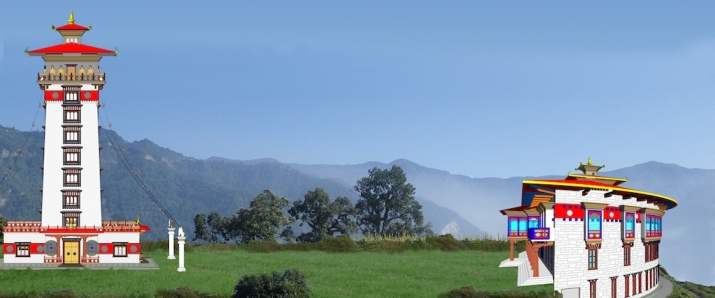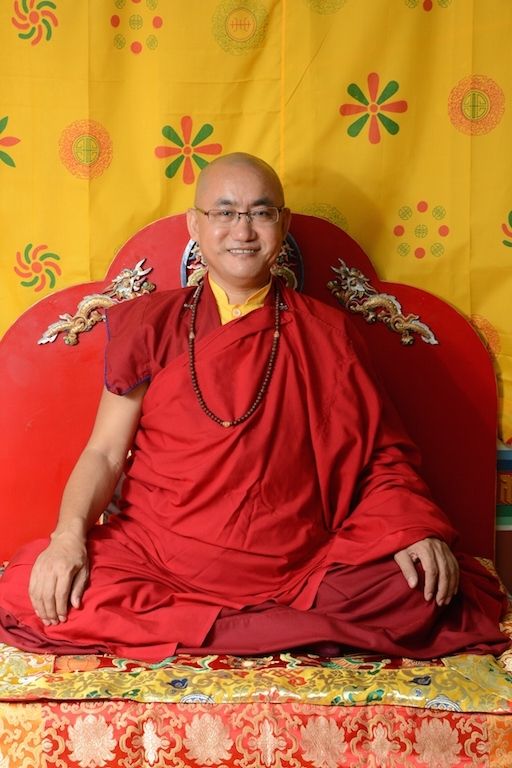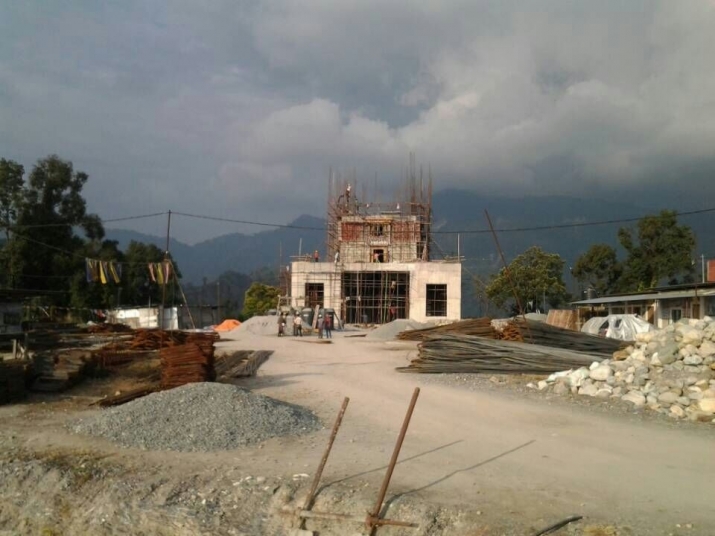FEATURES|THEMES|Art and Archaeology
Sangye Migyur Ling Lhakhang: A Tower for Milarepa in the Land of the Thunder Dragon
Buddhistdoor Global | 2014-12-05 |
 Concept design of Sangye Migyur Ling Lhakhang and environs. From the SML
Concept design of Sangye Migyur Ling Lhakhang and environs. From the SML“You cooked such delicious food for so many people. How many did you cook for?”
“We cooked with all sentient beings in mind.”
A team of chefs had this inspiring exchange with retired Hong Kong civil servant Peter Mann, who fittingly related the story to me over lunch. In 2011, he and the cooks had attended the “ground-breaking ceremony” to consecrate the 12-acre site of a new nine-story tower dedicated to Milarepa (1052–1135) in the border town of Phuentsholing, southern Bhutan. “The ground-breaking ceremony was also attended by His Holiness the Je Khenpo [currently Trulku Jigme Chhoeda Rinpoche],” says Peter, who is also vice-chairman of the Royal Commonwealth Society in Hong Kong.
This multi-storied landmark, estimated to cost over HK$20 million, is called Sangye Migyur Ling Lhakhang. The ceremony, attended by dozens of Bhutanese officials, members of the armed forces, and students, was a milestone following three years of construction. Three floors have been completed so far, but the tower will not be finished until 2017 at the earliest. By then, it will be the tallest structure in the entire country.
Sangye Migyur Ling Lhakhang is the inspiration of Bhutanese Karma Kagyu master Lama Kelzang. It is a replica of an 11th century structure erected by the Tibetan medieval poet-yogi Milarepa, famous for his journey from revenge-motivated witchcraft to enlightenment. The story goes that an unenlightened Milarepa, who desperately wanted to atone for practicing black magic to kill his mother’s enemies, sought out the translator Marpa to learn Buddhism. But the latter refused to teach him until he single-handedly built (and on Marpa’s orders) destroyed three towers, the fourth and final one being the original nine-story sekargutok at Lhodrag. There are already several replica towers in China.

Lama Kelzang. From the SML
In 2007, while visiting the replica tower in Qinghai Province, Lama Kelzang’s cousin suggested they make an aspiration to erect a similar structure in their homeland. “I was a bit hesitant at first, since I wasn’t sure if it would succeed. I was visiting His Eminence Sangye Nyenpa Rinpoche in Qinghai at the time, so I asked him to make a divination on the portents,” he says. Sangye Nyenpa Rinpoche’s affirmation of the project’s prospects helped to give Lama Kelzang faith in his aspiration. However, having enough funds to complete the project was a critical condition for committing to it. Lama Kelzang then sought the advice of the 17th Karmapa, Ogyen Trinley Dorje, on two occasions between 2007 and 2009. The Karmapa blessed Lama Kelzang’s intention both times. With the support of such senior masters, as well as that of the Je Khenpo, Lama Kelzang feels that the project is sufficiently buoyed by spiritual power.
“All Kagyu lineages revere Milarepa. I hope to have five hundred monks studying and living at the new site in the future. Tourists, pilgrims, and monastics will hear the name of Milarepa and benefit from its sacred power, regardless of where they come from or what they believe,” he says. “We will also have educational, cultural, and medical facilities to preserve our lineage and Bhutanese culture.”
Behind Lama Kelzang’s ambitious aspiration is the Sangye Migyur Ling Foundation (SML), a charity led by Peter and other organizers under Lama Kelzang’s spiritual guidance. Peter met Lama Kelzang shortly after losing a friend. Twin sisters Boffe Lee and Kitty Lee suffered their mother’s passing before meeting Lama Kelzang and becoming devout followers. Amy Cheng, who helps to fundraise for the SML, suggested that working on this project, as arduous as it may get, brings her benefits that exceed her contributions. “This project and practicing under Lama Kelzang have brought my life deep spiritual meaning,” she says. “The whole process has been hard for all of us. But this is a priceless blessing that we revere Lama Kelzang for.”
Currently, the commanding Boffe is a regional manager at artistic glassware purveyor Liuligongfang. Just a few blocks away in the neighborhood of Lai Chi Kok, her sharp-eyed sister specializes in construction materials (particularly waterproofing) at a firm in the same industrial building as Lama Kelzang’s center. They bring strengths critical to assuaging the main concerns of the Bhutanese. Peter has met many high-level Bhutanese figures and tries to manage the inevitable stress that comes with a huge non-profit construction project. “When I met the speaker of Parliament and the director of culture, I had to reassure them that the money wouldn’t dry up midway and that the construction would be able to withstand the elements in the region,” he says.
The construction site is in an earthquake zone, and environmental concerns include the area’s susceptibility to long and wet monsoon periods and the flaky, crumbly conditions of the soil. Sangye Migyur Ling Lhakhang needed a deep foundation to compensate for its height. This came at a price: the beautiful hill, which had to be flattened and removed. “I will never forget standing on top of that hill when I visited the site of the construction for the first time. As we climbed up, I saw an orchid and thought to myself how beautiful the borderland was: the dusty plains of India, and the green Bhutanese mountain behind us,” Peter recalls fondly.
There are plenty of old, derelict temples in the country that need maintenance. The government’s conservative attitude to temple building mirrors the caution with which Bhutan has handled tourism and foreign investment. There are three probable reasons why insiders in the Bureau of Religious Affairs approved Lama Kelzang’s application. The first is that the tower is affiliated with the Drukpa Kagyu school, Bhutan’s national spiritual lineage (it was for this reason that the Je Khenpo took a personal interest). Secondly, there is no tower dedicated to Milarepa in the country yet.
The third reason is geographical. Phuentsholing is accessible to Indians and Westerners who mainly come from Darjeeling and Dharamsala, and has potential to function as a Kagyu outpost close to the Hindu heartland for pilgrims and tourists traveling overland from India. “The previous government was exploring relations with China. But after the recent election, the winners quickly reaffirmed Bhutan’s historical economic reliance on India,” says Peter. The tower has the potential to serve as spiritual facilitator for ever-closer Bhutanese and Indian ties, something that the present government is keen on.
 The present construction site from a distance. From Peter Mann
The present construction site from a distance. From Peter MannPhase One is the construction of the tower and shrine hall. Phase Two will consist of the interior design and facilities, which include practice halls, libraries, and visitor facilities. This is where the SML team is truly pioneering and original: to counter environmental factors, Kitty tells me that the granite exterior will be coated with a waterproofing base after the tower is built and before paint is applied, a technology and expertise hitherto unknown in Bhutan. “We’ll use something called ‘prepared render’ from Singapore,” she says at our meeting. “The quality control is stringent because it’s formularized. Paint, tiles, and oil also need to be considered. I’m hoping to use a high grade of paint that can last at least a decade.”
Kitty also hopes to introduce sustainability to the project by taking advantage of solar and wind energy. Her hope is that the local environment will be minimally disrupted. “It’s all at the conceptual stage right now: I have a builder friend who will advise me on these issues next year,” she tells me excitedly. “Imagine having solar panels or components that naturally heat or cool a future restaurant or souvenir shop. It’ll be dear, but it’s worth it because it’s really important to preserve the pristine ecology of Bhutan.”
The team’s efforts are only the start of a herculean drive that involves many workers, planners, and engineers. “Raising funds is difficult,” agrees a laughing Boffe in her Liuligongfang office. “But we need to keep the money flowing to the project to ensure it can be completed.” This journey has been so transformative for her that she has “adopted” a total of nine Bhutanese boys, all of them junior monks. “They are my children,” she tells me proudly, showing me a photo of their joyful, mischievous faces. They gather round her lovingly, not as a good friend from Hong Kong, but as a maternal companion to their monastic lives. They will hopefully live and practice at Sangye Migyur Ling Lhakhang when it’s complete.
This project continues to touch many lives, from the spiritual family at the SML to the monks who will be studying in the completed tower. But it will not be until those hundreds of monks take up residence at Sangye Migyur Ling Lhakhang that the aspiration of their root guru, Lama Kelzang, is fulfilled.
Visit the Sangye Migyur Ling Foundation and find out more about Sangye Migyur Ling Lhakhang at their website: http://www.sml-foundation.org

Categories:
Comments:
Share your thoughts:













